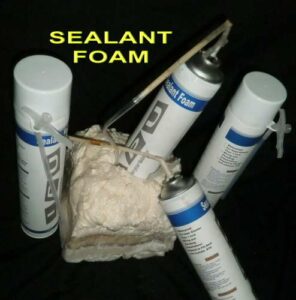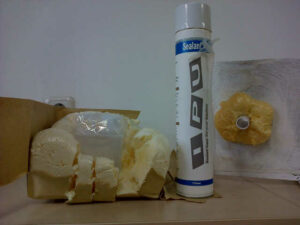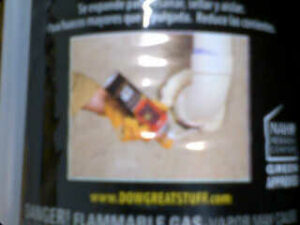polyurethane / polyurethane foam / polyurethane indonesia / polyurethane industri / polyurethane adalah / polyurethane coating / foam / foaming
Jenis polyurethane yang kami jual sebagai berikut
1. Polyurethane sprey (sealant foam)
Polyurethane jenis ini adalah jenis polyurethane yang dalam penggunaanya di semprotkan adapun pemakaiannya sangat sederhana tinggal mengocok kaleng lalu disemprotkan ke bagian mana yang akan di lapisi polyurethane tersebut.
kemasan dari prdouk ini dalam 1 kaleng ber isi 750 ml kalau di semprotkan sekitar menjadi +- 15 cm3







Harga polyurethane ini Rp 130.000,- / Kaleng
2. polyurethane lembaran
jenis polyurethane jenis lembaran ini biasanya digunakan untuk dinding kedam suara seperti pintu kamar mandi dan lain2.



Harga dari polyurethane lembaran ini
uk 200x100x1cm Rp 100.000,- / lembar
harga tinggal dikalikan dengan ketebalan yang diinginkan
2. polyurethane injec di lokasi
jenis polyurethane yang di injec dilokasi ini biasanya di gunakan di ducting sehingga panas dari atas tidak menembus kedalam ruangan



A polyurethane (PUR and PU) is polymer composed of a chain of organic units joined by carbamate (urethane) links.
Polyurethane polymers are formed by combining two bi- or higher functional monomers. One contains two or more isocyanate functional groups (with formula –N=C=O) and the other contains two or more hydroxyl groups (with formula –OH). The alcohol and the isocyanate groups combine to form a urethane linkage:
- ROH + R’NCO → ROC(O)N(H)R’ (R and R’ are alkyl or aryl groups)
This combining process, sometimes called condensation, typically requires the presence of a catalyst. More complicated monomers are also used.
Polyurethanes are used in the manufacture of flexible, high-resilience foam seating; rigid foam insulation panels; microcellular foam seals and gaskets; durable elastomeric wheels and tires; automotive suspension bushings; electrical potting compounds; high performance adhesives; surface coatings and surface sealants; synthetic fibers (e.g., Spandex); carpet underlay; and hard-plastic parts (e.g., for electronic instruments).
Polyurethane is also used for the manufacture of hoses and skateboard wheels as it combines the best properties of both rubber and plastic.
Polyurethanes are in the class of compounds called reaction polymers, which include epoxies, unsaturated polyesters, and phenolics.[5][6][7][8][9] A urethane linkage is produced by reacting an isocyanate group, -N=C=O with a hydroxyl (alcohol) group, -OH. Polyurethanes are produced by the polyaddition reaction of a polyisocyanate with a polyalcohol (polyol) in the presence of a catalyst and other additives. In this case, a polyisocyanate is a molecule with two or more isocyanate functional groups, R-(N=C=O)n ≥ 2 and a polyol is a molecule with two or more hydroxyl functional groups, R’-(OH)n ≥ 2. The reaction product is a polymer containing the urethane linkage, -RNHCOOR’-. Isocyanates will react with any molecule that contains an active hydrogen. Importantly, isocyanates react with water to form a urea linkage and carbon dioxide gas; they also react with polyetheramines to form polyureas. Commercially, polyurethanes are produced by reacting a liquid isocyanate with a liquid blend of polyols, catalyst, and other additives. These two components are referred to as a polyurethane system, or simply a system. The isocyanate is commonly referred to in North America as the ‘A-side’ or just the ‘iso’. The blend of polyols and other additives is commonly referred to as the ‘B-side’ or as the ‘poly’. This mixture might also be called a ‘resin’ or ‘resin blend’. In Europe the meanings for ‘A-side’ and ‘B-side’ are reversed. Resin blend additives may include chain extenders, cross linkers, surfactants, flame retardants, blowing agents, pigments, and fillers.
The first essential component of a polyurethane polymer is the isocyanate. Molecules that contain two isocyanate groups are called diisocyanates. These molecules are also referred to as monomers or monomer units, since they themselves are used to produce polymeric isocyanates that contain three or more isocyanate functional groups. Isocyanates can be classed as aromatic, such as diphenylmethane diisocyanate (MDI) or toluene diisocyanate (TDI); or aliphatic, such as hexamethylene diisocyanate (HDI) or isophorone diisocyanate (IPDI). An example of a polymeric isocyanate is polymeric diphenylmethane diisocyanate, which is a blend of molecules with two-, three-, and four- or more isocyanate groups, with an average functionality of 2.7. Isocyanates can be further modified by partially reacting them with a polyol to form a prepolymer. A quasi-prepolymer is formed when the stoichiometric ratio of isocyanate to hydroxyl groups is greater than 2:1. A true prepolymer is formed when the stoichiometric ratio is equal to 2:1. Prepolymers can be used as moisture cure polyurethane. Important characteristics of isocyanates are their molecular backbone, % NCO content, functionality, and viscosity.
The second essential component of a polyurethane polymer is the polyol. Molecules that contain two hydroxyl groups are called diols, those with three hydroxyl groups are called triols, et cetera. In practice, polyols are distinguished from short chain or low-molecular weight glycol chain extenders and cross linkers such as ethylene glycol (EG), 1,4-butanediol (BDO), diethylene glycol (DEG), glycerine, and trimethylolpropane (TMP). Polyols are polymers in their own right. They are formed by base-catalyzed addition of propylene oxide (PO), ethylene oxide (EO) onto a hydroxyl or amine containing initiator, or by polyesterification of a di-acid, such as adipic acid, with glycols, such as ethylene glycol or dipropylene glycol (DPG). Polyols extended with PO or EO are polyether polyols. Polyols formed by polyesterification are polyester polyols. The choice of initiator, extender, and molecular weight of the polyol greatly affect its physical state, and the physical properties of the polyurethane polymer. Important characteristics of polyols are their molecular backbone, initiator, molecular weight, % primary hydroxyl groups, functionality, and viscosity.
| PU reaction mechanism catalyzed by a tertiary amine |
 |
| carbon dioxide gas formed by reacting water and isocyanate |
 |
The polymerization reaction is catalyzed by tertiary amines, such as dimethylcyclohexylamine, and organometallic compounds, such as dibutyltin dilaurate or bismuth octanoate. Furthermore, catalysts can be chosen based on whether they favor the urethane (gel) reaction, such as 1,4-diazabicyclo[2.2.2]octane (also called DABCO or TEDA), or the urea (blow) reaction, such as bis-(2-dimethylaminoethyl)ether, or specifically drive the isocyanate trimerization reaction, such as potassium octoate.
